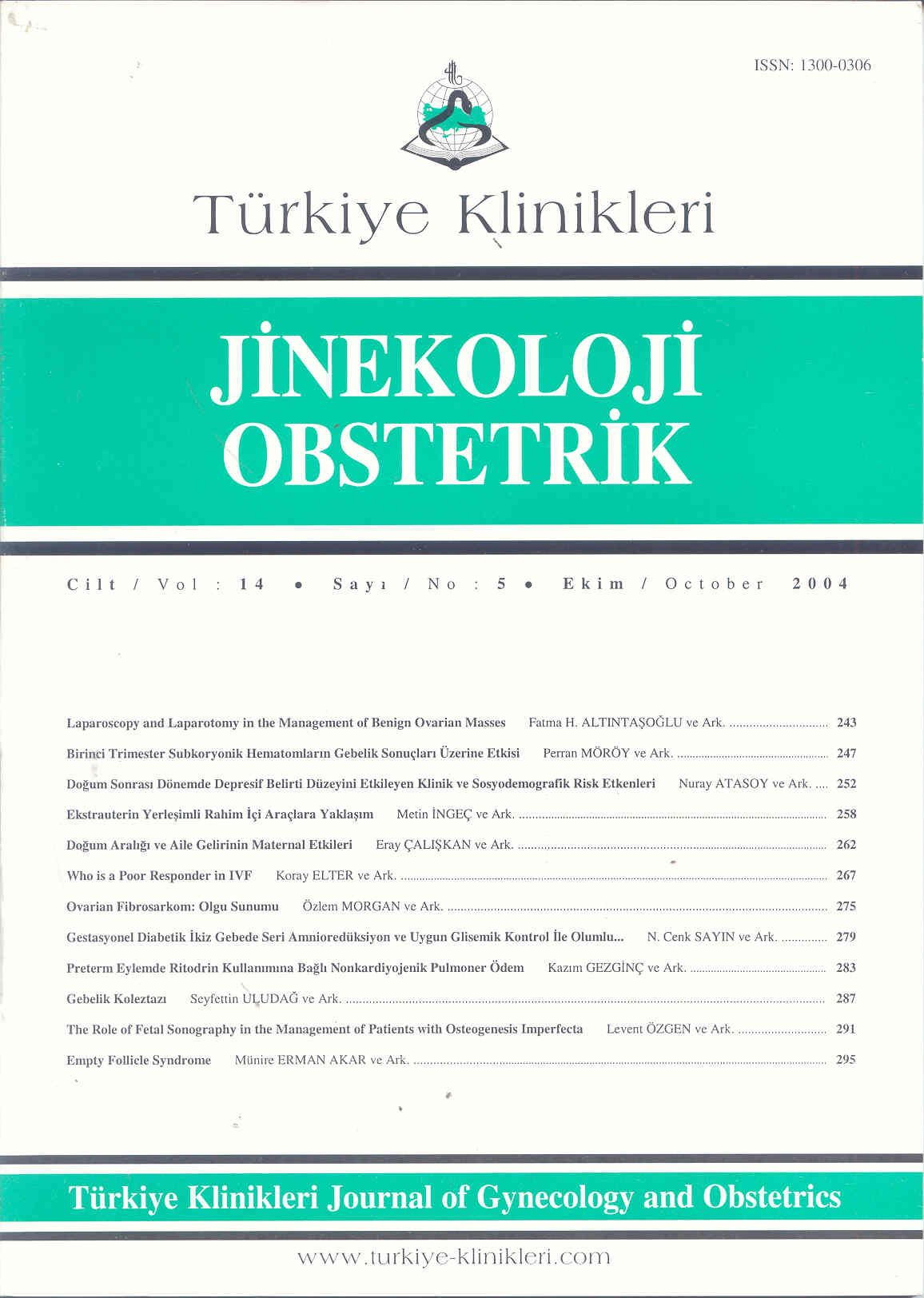Open Access
Peer Reviewed
ORIGINAL RESEARCH
2773 Viewed973 Downloaded
BENİGN OVARİAN KİTLELERE YAKLAŞIMDA LAPAROSKOPİ VE LAPAROTOMİ
BENİGN OVARİAN KİTLELERE YAKLAŞIMDA LAPAROSKOPİ VE LAPAROTOMİ
Turkiye Klinikleri J Gynecol Obst. 2004;14(5):243-6
Article Language: TR
Copyright Ⓒ 2025 by Türkiye Klinikleri. This is an open access article under the CC BY-NC-ND license (http://creativecommons.org/licenses/by-nc-nd/4.0/)
ÖZET
Amaç: Malignite şüphesi olmayan ovarian kitlelere yaklaşımda laparoskopi ve laparotomi sonuçlarının değerlendirilmesi. Gereç ve Yöntemler: Ovarian kitle nedeniyle cerrahi yaklaşım gereken yüzaltı hastaya laparoskopi (n:52) veya laparotomi (n:54) uygulandı. Dahil edilme kriterleri ultrasonografik olarak <=10cm. olması ,malignite şüphesi olmaması ve kistik kitle olması idi. Bulgular: Demografik karakteristik olarak iki grup arasında fark yoktu. Ortalama ovarian boyut laparotomi grubunda 8.3cm. laparoskopi grubunda 8.1cm idi. İki vaka dışında bütün ovarian kitleler benign idi. Her iki grupta da patolojik olarak en sık endometriotik kist ve dermoid kist saptandı.En çok tercih edilen cerrahi yaklaşım kistektomiydi.Laparoskopik yaklaşımda operasyon süresi uzamadı. Her iki prosedürde de benzer postoperatif ağrı, analjezik ihtiyacı, hastanede kalma süresi ve iyileşme süresi saptandı. Her iki grupta da inraoperatif veya postoperatif hayatı tehdit eden komplikasyon olmadı. Sonuç: Operatif laparoskopi ve laparotomi benign ovarian kitlelere yaklaşımda başarıyla uygulanabilir. Her iki prosedürün de birbiri üzerine avantajları vardır. Cerrah kendisini en başarılı ve güvende hissettiği prosedürü seçmelidir.
Amaç: Malignite şüphesi olmayan ovarian kitlelere yaklaşımda laparoskopi ve laparotomi sonuçlarının değerlendirilmesi. Gereç ve Yöntemler: Ovarian kitle nedeniyle cerrahi yaklaşım gereken yüzaltı hastaya laparoskopi (n:52) veya laparotomi (n:54) uygulandı. Dahil edilme kriterleri ultrasonografik olarak <=10cm. olması ,malignite şüphesi olmaması ve kistik kitle olması idi. Bulgular: Demografik karakteristik olarak iki grup arasında fark yoktu. Ortalama ovarian boyut laparotomi grubunda 8.3cm. laparoskopi grubunda 8.1cm idi. İki vaka dışında bütün ovarian kitleler benign idi. Her iki grupta da patolojik olarak en sık endometriotik kist ve dermoid kist saptandı.En çok tercih edilen cerrahi yaklaşım kistektomiydi.Laparoskopik yaklaşımda operasyon süresi uzamadı. Her iki prosedürde de benzer postoperatif ağrı, analjezik ihtiyacı, hastanede kalma süresi ve iyileşme süresi saptandı. Her iki grupta da inraoperatif veya postoperatif hayatı tehdit eden komplikasyon olmadı. Sonuç: Operatif laparoskopi ve laparotomi benign ovarian kitlelere yaklaşımda başarıyla uygulanabilir. Her iki prosedürün de birbiri üzerine avantajları vardır. Cerrah kendisini en başarılı ve güvende hissettiği prosedürü seçmelidir.
ANAHTAR KELİMELER: Ovarian kitleler, laparoskopi, laparotomi
ABSTRACT
Objective: To evaluate the results of laparoscopy and laparotomy in the management of ovarian masses which are not suspected to be malignant. Material and Methods: One hundred and six patients requiring surgical management for ovarian masses were assigned to laparoscopy(n:52) or laparotomy(n:54).Inclusion criteria was cystic masses those were not suspected to be malignant with a diameter of <= 10 cm. in ultrasonographic measurements. Results: There were no differences in demographic characteristics between the two groups.Mean ovarian size in the laparotomy group was 8.3 cm., mean ovarian size in the laparoscopy group was 8.1 cm. All of the ovarian masses were benign except two cases.Endometriotic cysts and dermoid cysts were the most common pathological findings in both groups. Cystectomy was the most preferred operative management. Operation time was not increased with the laparoscopic approach. Both two procedures (L/S and L/P) were associated with similar postoperative pain, analgesic requirement,hospital stay and recovery period.There were no life threatening intraoperative or postoperative complication in both groups. Conclusion: Operative laparoscopy and laparotomy can be used in the management of benign ovarian masses satisfactorily. Both two procedures have benefits over each other. Surgeon should select procedure in which he feels more success and safety.
Objective: To evaluate the results of laparoscopy and laparotomy in the management of ovarian masses which are not suspected to be malignant. Material and Methods: One hundred and six patients requiring surgical management for ovarian masses were assigned to laparoscopy(n:52) or laparotomy(n:54).Inclusion criteria was cystic masses those were not suspected to be malignant with a diameter of <= 10 cm. in ultrasonographic measurements. Results: There were no differences in demographic characteristics between the two groups.Mean ovarian size in the laparotomy group was 8.3 cm., mean ovarian size in the laparoscopy group was 8.1 cm. All of the ovarian masses were benign except two cases.Endometriotic cysts and dermoid cysts were the most common pathological findings in both groups. Cystectomy was the most preferred operative management. Operation time was not increased with the laparoscopic approach. Both two procedures (L/S and L/P) were associated with similar postoperative pain, analgesic requirement,hospital stay and recovery period.There were no life threatening intraoperative or postoperative complication in both groups. Conclusion: Operative laparoscopy and laparotomy can be used in the management of benign ovarian masses satisfactorily. Both two procedures have benefits over each other. Surgeon should select procedure in which he feels more success and safety.
MENU
POPULAR ARTICLES
MOST DOWNLOADED ARTICLES





This journal is licensed under a Creative Commons Attribution-NonCommercial-NoDerivatives 4.0 International License.










